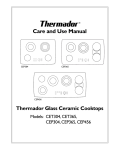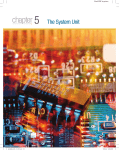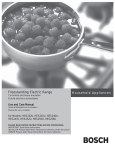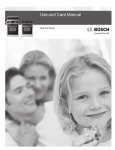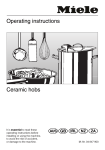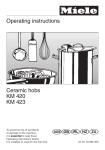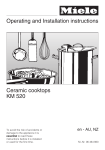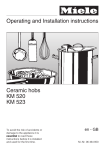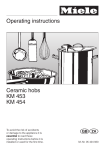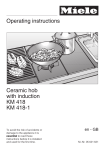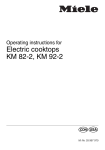Download Miele KM 87-2 Operating instructions
Transcript
Operating instructions Ceramic hobs KM 84-2, KM 87-2 KM 94-2, KM 97-2 @Q\ä} M.-Nr. 03 998 291 Contents Contents Help to protect our environment. . . . . . . . . . . . . . . . . . . . . . . . . . . . . . . . . . . . . . 3 Description of the appliance . . . . . . . . . . . . . . . . . . . . . . . . . . . . . . . . . . . . . . . . . 4 Warning and Safety Instructions . . . . . . . . . . . . . . . . . . . . . . . . . . . . . . . . . . . . . 6 Before using for the first time . . . . . . . . . . . . . . . . . . . . . . . . . . . . . . . . . . . . . . . . 9 Hob controls . . . . . . . . . . . . . . . . . . . . . . . . . . . . . . . . . . . . . . . . . . . . . . . . . . . . . 10 Cooking areas - Description . . . . . . . . . . . . . . . . . . . . . . . . . . . . . . . . . . . . . . . . 12 Cooking areas - Use. . . . . . . . . . . . . . . . . . . . . . . . . . . . . . . . . . . . . . . . . . . . . . . 13 Cleaning and care . . . . . . . . . . . . . . . . . . . . . . . . . . . . . . . . . . . . . . . . . . . . . . . . 15 Correcting minor faults . . . . . . . . . . . . . . . . . . . . . . . . . . . . . . . . . . . . . . . . . . . . 17 After Sales Service. . . . . . . . . . . . . . . . . . . . . . . . . . . . . . . . . . . . . . . . . . . . . . . . 18 Electrical connection and technical data. . . . . . . . . . . . . . . . . . . . . . . . . . . . . . 19 Appliance dimensions . . . . . . . . . . . . . . . . . . . . . . . . . . . . . . . . . . . . . . . . . . . . . 21 Instructions for building-in . . . . . . . . . . . . . . . . . . . . . . . . . . . . . . . . . . . . . . . . . 22 Help to protect our environment Help to protect our environment Disposal of packaging The transport and protective packing is mostly manufactured from the following re-usable materials: . . . Corrugated paper / card - mostly from recycled materials. . . . Polyethylene foil (PE) partly from secondary raw materials. Disposal of your old machine Old machines contain materials which can be recycled. Please contact your local authorities or scrap merchant about potential recycling schemes, before disposing of the appliance. Read the notes on page 7 before disposing of the appliance. Rather than just throwing these materials away, please take them to the nearest local authority collection point for specific waste. 3 Description of the appliance Description of the appliance KM 84-2 / KM 87-2 3 4 2 1 5 7 8 7 6 KM 94-2 / KM 97-2 3 4 2 5 1 8 12 8 11 6 10 8 9 8 7 Description of the appliance Description of the appliance KM 84-2 / KM 87-2 b Control panel c Cooking area - Ø 14.5 cm d Cooking area - Ø 18 cm KM 87-2: Halogen e Residual heat indicator f Connection cable with plug, approx. 1.10 m long. N.B. Plug according to country. g Control for the front cooking area h Cooking area indicator lights i Control for the rear cooking area KM 94-2 / KM 97-2 b Control panel c Cooking area - Ø 18 cm KM 97-2: Halogen d Cooking area - Ø 14.5 cm e Cooking area - Ø 14.5 cm Data plate Because the data plate is no longer visible once the appliance has been built in a 2nd data plate is supplied which should be stuck into the space provided on page 15 of these instructions under After Sales Service. Special accessories Special accessories are available from your Miele Dealer or from the Spare Parts Department. Stainless steel cover EA 80 A stainless steel cover is available for the KM 84-2 / KM 87-2 ceramic hobs. Check availability in each country. For installation of the cover a minimum distance of 510 mm (or respective distance for cooker hood in installation instructions) is required between the worktop and wall units. KM 97-2: Halogen f Cooking area - Ø 18 cm g Connection cable, approx. 1.30 m long h Control for the front right cooking area i Cooking area indicator lights j Control for the rear right cooking area k Residual heat indicators l Control for the rear left cooking area m Control for the front left cooking area 5 Warning and Safety Instructions Warning and Safety Instructions This appliance complies with all relevant legal safety requirements. Improper use of the appliance can, however, present a risk of both personal injury and material damage. Before installation and before using the appliance for the first time read the operating instructions carefully. They give information on safety, on the operation and care of the appliance. This way you will avoid the risk of accidents and damage to the appliance. The appliance is intended for domestic use. Should it be installed for commercial use the relevant regulations must be observed. For safety reasons, this appliance may only be operated as a built-in appliance. This is necessary to ensure that all electric components are shielded. The electrical safety of the appliance can only be guaranteed when continuity is complete between the appliance and an effective earthing system which complies with local and national regulations. It is most important that this basic safety requirement is regulary tested by a qualified electrician. The manufacturer can not be held responsible for the consequences of an inadequate earthing system. 6 Installation work and repairs may only be carried out by suitably qualified and competent persons to ensure safety. Repairs and other work by unqualified persons could be dangerous. Do not connect the appliance to the mains electricity supply by an extension lead. Extension leads do not guarantee the required safety of the appliance. Please ensure that the domestic supply corresponds to the information on the machine’s data plate. The appliance is only completely isolated from the electricity supply when it is switched off at the wall socket, or the mains fuse is withdrawn. Do not pull by the mains cable, but by the plug when withdrawing the plug from the socket. The distance between the hob and a cooker hood should be at least: 55 cm for electric hobs. Australia: 60 cm! To avoid the danger of fire do not flambe under a cooker hood. Do not let small children touch the appliance during operation. Not only do the cooking areas of the ceramic hob heat up, but also the control panel. Danger of burning. Keep all pans out of the reach of children. Supervise use of the hob by the elderly or infirm. Warning and Safety Instructions Warning and Safety Instructions Do not leave the appliance unattended when cooking with oils and fats as these are fire hazards if overheated. When switched on, the cooking areas heat up extremely quickly. The residual heat indicators will show whether a cooking area is switched on, or is still hot. Always ensure that food is sufficiently cooked or reheated. Many factors will affect the overall cooking time, including the size and amount of food, its temperature, changes to the recipe and the shape and size of cooking container. Some foods may contain micro organisms which are only destroyed by thorough cooking, therefore when cooking or reheating foods, e.g. poultry, it is par-ticulary important that the food is fully cooked through. If in doubt select a longer cooking or reheating time. It is essential to ensure that food has been evenly and sufficiently heated, and to check that it is thoroughly cooked, turning or stirring during cooking if necessary. When using kitchen appliances connected to sockets near the ceramic hob ensure that the cable cannot touch a heated hob or pan. Do not use the control panel as a resting place for pots and pans. Do not use the ceramic hob to heat up the room. The high temperatures of the hob could cause inflammable objects in the vicinity to burn. Only for Halogen hobs Do not stare at halogen cooking areas when heating if there is no pan in place. This could cause damage to the eyes. Do not use the hob as a resting place for anything else. This could lead to a danger of the article catching fire, if the hob were to be switched on inadvertently. Do not use plastic or aluminium foil containers. These melt at higher temperatures and could damage the ceramic surface. In the event of any breakages or cracks occuring in the ceramic hob it must be switched off immediately and disconnected from the electricity supply. Contact the Miele Service Department. Do not use the hob until the damaged ceramic plate has been replaced. Continued use would be dangerous as liquids etc. boiling over could penetrate the electrical components through the crack. 7 Warning and Safety Instructions Warning and Safety Instructions Do not allow either solid or liquid sugar or pieces of plastic or aluminium foil to get onto the ceramic hob when it is hot. If this should occur do not switch the appliance off. Scrape all the sugar, plastic, or aluminium remains from the hob with a sharp blade taking care not to burn yourself. If this is allowed to cool before the hob has been cleaned, the ceramic surface will be susceptible to pitting or even cracking. Do not use any pots or pans on the ceramic hob with bases with pronounced edges or ridges. These could scratch or scour the hob surface permanently. Do not push enamelled pots or pans such as chip pans across the ceramic hob as this can cause scratches to occur. Do not drop anything on the ceramic hob. Dropping a salt cellar, for example, could be the cause of damage in certain circumstances. If no wooden protective board (see p. 19) is fitted between the hob and a drawer underneath, spray canisters or inflammable substances must not be stored in the drawer. Any cutlery trays must be made of a heat resistant material. 8 Under no circumstances use a steam-cleaning appliance to clean the ceramic hob. The steam could penetrate to live components and cause a short circuit. In countries which may be subject to infestation by cockroaches or other vermin, pay particular attention to keeping the appliance and its surroundings in a clean condition at all times. Any damage which might be caused by cockroaches or other vermin will not be covered by the appliance guarantee. Keep these instructions in a safe place and pass them on to any future user. Disposal of discarded appliances Before disposal of an old appliance, turn off at the mains, disconnect and remove the appliance cable at both ends and render useless. This is intended to prevent the discarded appliance from being a hazard. The manufacturer cannot be held liable for damage caused by noncompliance with safety instructions. Before using for the first time Before using for the first time Read the ”Warning and Safety instructions“ before using for the first time. Thoroughly clean the ceramic hob before use and then clean regularly after use when just warm to the touch or cold (see ”Cleaning and care“). There might be a slight smell on first use due to drying effect of the insulation material. 9 Hob controls Hob controls All cooking areas are controlled by variable energy regulators. By using these energy regulators, the temperature can be freely selected. The controls can be turned either clockwise or anti-clockwise. The indicator light for each cooking area comes on as soon as the respective energy regulator is turned to a setting. It goes out when the energy regulator is turned to the ”0“ position. A resistance is felt between settings 7 and 8 to indicate that a higher temperature range is being reached. 10 Correct procedure: Place saucepan of food on cooking area. Select a high number for boiling or sealing in juices. Should a trace of steam become visible on the edge of the lid, switch to a lower number for continued cooking. Turning the temperature down at the right time . . . . . . prevents food from overcooking. . . . prevents food from burning. . . . saves energy. Hob controls Table of settings for energy regulators Setting Melting butter, chocolate etc. Dissolving gelatine Preparing yoghurt 1-2 Keeping food warm Warming small quantities of food / liquid Thickening sauces containing egg yolk and butter Cooking milk pudding Omelettes 1-3 Defrosting deep frozen food Cooking rice, pasta, porridge Steaming fruit, vegetables, fish Cooking broths, pulse soups Braising meat, fish, vegetables Cooking dumplings, potatoes, soups Preparing jams, jellies, stewed fruit Frying chops, liver, sausage, fish, eggs 3-5 4-6 7 - 10 Frying pancakes, dropped scones and other liquid batters Frying steaks 9 - 12 Deep frying (chips, fritters) Boiling water These figures, which envisage approx. 4 helpings, should only be taken as a guide. With deep pans, large quantities, or without the lid on a higher setting is needed. With smaller quantities select a lower setting. 11 Cooking areas - Description Cooking areas - Description Cooking areas - diameter The cooking areas are clearly marked on the hob unit. Only the particular area which has been switched on will be heated. The rest of the hob surface remains relatively cool. Residual heat indicator Each cooking area has a residual heat indicator. When a cooking area is switched on its residual heat indicator lights up. It only goes out after the cooking area has been switched off and this area of the ceramic surface has reached a temperature safe to the touch. Temperature limiter All cooking areas are fitted with a temperature limiter, which switches the heating element off if the temperature under the ceramic surface is too high. The temperature limiter switches the heating element on again after the temperature has returned to a safe level for the ceramic material. The temperature limiter mainly reacts . . . when unsuitable cooking utensils are used e.g. saucepans with uneven bases or which are too small. . . . when cooking areas are used without a saucepan. 12 The temperature limiter can also be activated . . . . . . even when the utensils are suitable. The reason for this could be light coloured saucepan bases (heat reflection), bad transfer of heat from saucepan base to foodstuff (saucepans with bases which store heat) etc. Important note Whilst the ceramic cooking areas are heating up, a ”humming“ noise may be noticed. This is caused by magnetization of the heating filaments. As the cooking areas heat up, the humming noise diminishes and finally ceases altogether. For halogen cooking areas only: The radiant elements work together with the halogen lamps. This gives a quicker heat transfer to the pan base, resulting in a shorter heating-up period. Cooking areas - Use Cooking areas - Use Saucepans Saucepan size The following notes are designed to enable you to . . . make the best use of energy when using your ceramic hob. . . . prevent food boiling over and burning on to the ceramic hob. Saucepans are available which have been specially tested for use on a glass ceramic hob unit. The diameter of the saucepan should be a little larger than that of the cooking area. Saucepan lids Saucepan bases So that optimum energy consumption is achieved during cooking, only saucepans with bases as flat as possible, or very slightly concave, should be used. When the saucepan is hot, the base should rest evenly on the ceramic surface. A lid on the saucepan will prevent heat from being lost. Only use saucepans approved for use on ceramic hobs. Do not use pots or pans on the ceramic hob with bases with pronounced edges or ridges. These could scratch or scour the hob surface permanently. 13 Cooking areas - Use Cooking areas - Use Note: Do not use any pots or pans on the ceramic hobs with bases with pronounced edges or ridges. These could scratch or scour the hob surface permanently. Place a saucepan on the cooking area before switching on the appliance to save energy. The ceramic surface and the base of the saucepan should be clean and dry. This saves unnecessary cleaning after cooking and protects the cooking area. Care should be taken that no sandlike grains are on the hob when cooking is to begin. If such grains should find their way under the saucepan when it is pushed across the hob, the grains could cause scratches on the surface. Do not push enamelled baking sheets, frying pans and saucepans to and fro across the ceramic surface. Otherwise scratches may occur. 14 When using aluminium or stainless steel utensils, the metal can affect the ceramic surface by leaving mother-of-pearl coloured flecks behind. These marks can be removed most easily if they are treated immediately they appear with a special proprietary cleaning agent (see chapter ”Cleaning and Care“). Do not allow either solid or liquid sugar or pieces of plastic or aluminium foil to get onto the ceramic hob unit when it is hot. If this should occur do not switch the appliance off. Scrape all the sugar, plastic or aluminium remains from the hob with a sharp blade taking care not to burn yourself. If this is allowed to cool before the hob has been cleaned, the ceramic surface will be susceptible to pitting or even cracking. Cleaning and care Cleaning and care Ceramic hob Basically you can use the same cleaning agents for the ceramic hob as you would for ordinary glass surfaces. Never use scouring agents or pads, or strong cleaners such as oven sprays or stain removers, as these could harm the surface. Clean after each use Wipe off any minor spills with just a damp cloth. If the hob is cleaned with a proprietary cleaner, for example washing up liquid, light blue staining might occur. These stains can be removed with one of the proprietary agents mentioned, although they can be stubborn, and may take several applications. Hardened spills should be carefully scraped off with a sharp blade. The hob surface should then be rubbed clean with a damp cloth. Light marks with a metallic sheen (Aluminium deposits) on the hob surface can be removed once the hob has cooled down by using a suitable proprietary cleaner. Lime deposits on the ceramic surface, caused for example by water boiling over, can be removed with vinegar or a proprietary ceramic hob cleaner. Removal of sugar, or syrups, plastic or aluminium foil On no account turn off the cooking area affected. Scrape off the sugar or other residue thoroughly from the hot hob with a sharp blade taking care not to burn yourself. Then switch off the hob, and when it is cool, clean with a recommended cleaner. Suitable proprietary cleaners There are proprietary cleaners on the market for ceramic hobs. Follow the manufacturer’s instructions. Do not apply to the hob when still hot. After applying the proprietary cleaning agent let it dry and then rub it off using paper kitchen towels. Always make sure that every trace of cleaning agent has been removed, as it could have an adverse effect on the hob when heated up. Remove using a damp cloth. Some cleaners incorporate a silicone agent which acts as a protective film on the ceramic hob. It makes the hob surface smoother and prevents water and soiling adhering to the surface. However, cooking at high temperatures reduces the effect and the cleaner needs to be reapplied for renewed effect. 15 Cleaning and care Cleaning and care By always cleaning your ceramic hob with one of these cleaning agents you will help to avoid the damage caused by sugar and syrups and aluminium foil deposits. Facia panel / Control knobs Do not use any scouring agents or pads on the knobs or facia, as these could cause damage. Clean the hob controls and the facia panel with hot water and a little washing up liquid. After application rub dry with a clean cloth. 16 Correcting minor faults Correcting minor faults Repairs to electrical appliances should only ever be carried out by a competent person. Unauthorised repairs can be dangerous. Some minor problems, however, can be dealt with as follows: What to do if . . . . . . a humming sound is heard while the ceramic hob is heating up? This is not a fault. As the cooking areas heat up, the humming disappears completely. . . . a resistance is felt between settings 7 and 8? This is not a fault. The resistance is there to indicate that a higher temperature range is being reached. . . . the cooking area does not get hot when switched on and the cooking area indicator light does not come on? Check that the mains fuse is in order. If it is call the Customer Service Department for assistance. 17 After Sales Service After Sales Service In the event of any fault which you cannot correct yourself, or if the appliance is under guarantee, please contact Your Miele Dealer or The Miele Service Department The address of the nearest Service Department is given on the back page. When contacting the Service Department, please quote the Model and Serial No. of the appliance, both of which can be found on the data plate. Space for data plate supplied 18 Electrical connection and technical data Electrical connection and technical data Electrical connection General notes Electrical connection of the appliance should be undertaken by a qualified electrician in strict accordance with national and local safety regulations. For extra safety it is advisable to install a residual current device (RCD), with a trip current of 30 mA. The Technical data table (next page) gives details for each appliance. The data plate gives the necessary data for connection. See page 15. Electrical connection U.K., AUS (IRL, NZ, ZA) The appliances are supplied with a mains cable for connection to an a.c. single phase 240 V (230 V), 50 Hz supply. The fuse rating and rated load are given on the data plate. For the KM 84-2 / KM 87-2 combiset units connection should be made via a fused plug (U.K. only) and switched socket. The On-Off switch should be easily accessible after the appliance has been built in. For the KM 94-2 / KM 97-2 combiset units connection should be made via a suitable isolator which complies with national and local safety regulations. Important: The wires in the mains lead are coloured in accordance with the following code: Green/yellow = earth Blue = neutral Brown = live As the colours of the wires in the mains lead of this appliance may not correspond with the coloured markings identifying the terminals in your plug, proceed as follows: The wire which is coloured green and yellow must be connected to the terminal in the plug which is marked with the letter E or by the earth symbol z or coloured green or green and yellow. The wire which is coloured blue must be connected to the terminal which is marked with the letter N or coloured black. For U.K.: The wire which is coloured brown must be connected to the terminal which is marked with the letter L or coloured red. For Australia: The wire which is coloured brown must be connected to the terminal which is marked with the letter A or coloured red. WARNING THIS APPLIANCE MUST BE EARTHED 19 Electrical connection and technical data Electrical connection and technical data Non-rewireable plugs BS 1363 (U.K.) If this machine or appliance is fitted with a non-rewireable plug, the following information applies: If the socket outlets are not suitable for the plug supplied with this product, it must be cut off and an appropriate plug fitted. The plug cut from the flexible cord should be disposed of and on no account be inserted into a 13 A socket elsewhere in the house (electric shock hazard). The fuse cover must be re-fitted when changing the fuse, and if the fuse cover is lost, the plug must not be used until a suitable replacement is obtained. The colour of the correct replacement cover is that of the coloured insert in the base of the plug, or the colour that is embossed in words in the base of the plug (as applicable to the design of plug fitted). The correct fuse rating of the replacement fuses that are ASTA approved to BS 1362 should be fitted. Replacement fuse covers may be purchased from your local electrical suppliers, electricity showrooms, or Miele Service Agent. Technical data Total connected load – U.K. – IRL, ZA – AUS – NZ Electrical connection – U.K. – IRL, ZA – AUS – NZ Fuse rating – U.K., IRL, ZA – AUS, NZ Plug rating AUS, NZ Connection cable Core cable, 4-core KM 84-2 KM 87-2 KM 94-2 KM 97-2 2900 W 2660 W 2900 W 2660 W 3100 W 2900 W n/a n/a 5800 W 5320 W 5800 W 5320 W 5800 W 5760 W n/a n/a ~ 50 Hz ~ 50 Hz ~ 50 Hz ~ 50 Hz 240 V 230 V 240 V 230 V ~ 50 Hz 240 V ~ 50 Hz 230 V n/a n/a 13 A 13 A 15 A 1.10 m 1.10 m The KM 84-2 and KM 87-2 need a 3 x 1.5 mm2 core cable, should the connection cable ever need to be replaced. The KM 94-2 and KM 97-2 need a 3 x 2.5 mm2 core cable, should the connection cable ever need to be replaced. 20 ~ 50 Hz ~ 50 Hz ~ 50 Hz ~ 50 Hz 240 V 230 V 240 V 230 V ~ 50 Hz 240 V ~ 50 Hz 230 V n/a n/a 30 A 20 A 30 A 1.30 m 1.30 m Appliance dimensions Appliance dimensions KM 84-2, KM 87-2 KM 94-2, KM 97-2 21 Instructions for building-in Instructions for building-in These hobs are classified as ”Y“ class for heat protection. There may be a wall at the rear and wall or tall units at one side. On the other side, however, no unit or divider must stand higher than the hob. 22 There must be a minimum distance of 30 mm between the hob and adjacent furniture, (e.g. tall unit) owing to the heat radiated from the elements. Instructions for building-in Instructions for building-in For Australia only Prepare the worktop cut-out as illustrated. Dimension ”B“ applies for a combination of appliances and is given on the chart. b cooktop c worktop d removable barrier For safety reasons, a removable barrier must be installed as shown to ensure that inadvertant contact with the hot underside is prevented. The distance between the lower edge of the worktop and the upper edge of the removable barrier must be a minimum of 125 mm. Instructions for building-in Instructions for building-in 2 zone Combiset 1 element 2 elements 3 elements 4 elements 5 elements Depth in mm Width (= Dimension B) in mm 490 490 490 490 490 265 558 851 1144 1437 490 490 490 560 1143 1728 Stick the seal provided f under the edge of the hob. 4 zone Combiset 1 elements 2 elements 3 elements Combination One 2 zone + one 4 zone 490 851 Two 2 zone + one 4 zone 490 1143 Three 2 zone + one 4 zone 490 1437 One 2 zone + two 4 zone 490 1436 Two 2 zone + two 4 zone 490 1729 loosen Extractor (e.g. DA 8-2) For building in between two appliances: - Dimension B increases by 90 mm. For building in at the end of a combination: - Dimension B increases by 98 mm. tighten b Appliance c Tensioning screw d Clamp e Worktop f Seal Turn the tensioning screws c in the clamps on the appliance b in an anti-clockwise direction until a resistance is met and turn the clamps to the left. Place the appliance into position, turn the clamps and tighten the tensioning screws until the clamps press into the worktop e. Connect the appliance to the electricity supply. When building-in several Combiset units, a spacer bar must be fitted between the units. It is supplied with its own installation instructions. 24 25 26 27 Alteration rights reserved / 22 AUS, GB, IRL, NZ, ZA - 3297




























